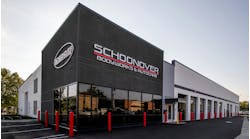Sept. 26, 2017—In July, UTI-Rancho Cucamonga (California) became the first Universal Technical Institute campus to launch a new welding technology program. The first class was filled to capacity, illustrative of strong student interest.
In August, UTI expanded the program to the Avondale campus in the Phoenix area. And student and employer interest in the program is high in anticipation of classes scheduled to begin in January 2018, said Michael Romano, UTI-Avondale campus president.
Each individual class will be open to 24 students to start out for the 9-month program, with three different classes running during the morning, afternoon and evening. If those classes do well, it opens the opportunity to bring in more students on not only the Avondale campus, but other UTI campuses as well.
Romano spoke with FenderBender about the program and how it could help alleviate some of the damage caused by the technician shortage.
How did the welding technology program come together?
UTI extends to the transportation side of industry. We’ve had collision programs for a number of years in Houston, Sacramento, Long Beach. Over past two years, we’ve dipped our toes into the welding program waters.
Classes have been filled since the a start of the program. We’re now looking at other locations across the country, looking to see if it makes sense in those markets to expand. We identified the Avondale campus is ideal place for that. Will have first class in January 2018. We began enrolling for that start and other subsequent parts. Interest is very high.
Do you think this class could stir up some interest in students and help solve the technician shortage?
Employees are hurting to find technicians. The issue goes back 30 years. From UTI’s standpoint, we support all types of CE (continuing education). Not either/or, but any and all. But over the years, high schools encourage kids to go after a four-year degree, and we saw funding go down for vocational training. We’ve seen a decline in the number of students that are aware this is viable career option. Some students don’t know difference between flat blade and phillips screwdriver.
At the same time, most cars these days are so technology driven. So, when you look at it from a high school’s standpoint, it’s just costly. An effective welding program requires so much raw material consumption alone. So we’re focusing on vehicle technology, trying to bring in students interested in the next phase of welding.
Would students in this program head into collision repair, then?
The knowledge can transfer. We have collision programs where they learn bodywork and welding. This is really focused on just welding, but welders can go out and do that work within the collision industry. As we work on partnership with the industry, they'll take those individuals into their shops, so it helps fill that gap.
Welding is an art in collision. Not everyone can do it. You really do need nice steady hands, natural talent to do it. For our employers, that’s a big opportunity.
Another big differentiation for that UTI provides: For past 52 years of business, we’ve created employer networks. We have relationships all across the country. We have over 2,700 locations across the country that have contractual obligations with us. They will do tuition reimbursement and offer programs for graduates. Certainly that employer network gets that employee out in the market.



